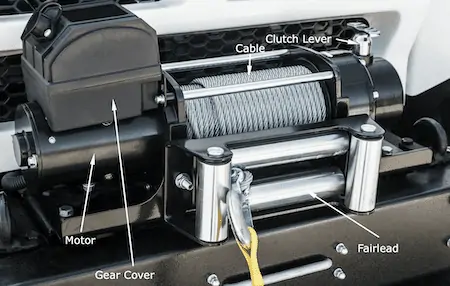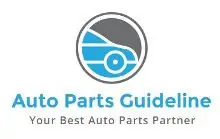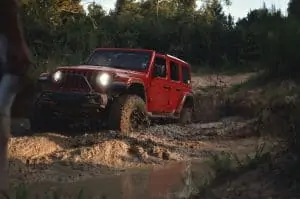Being an off-road driving enthusiast, you always have the potential risk of getting stuck with your car in the middle of nowhere. That might be the most probable reason you have given a thought about installing a winch in your vehicle.
Prevention is always better than cure, and a cautious mind never falls prey to unusual traps. It is always better to have a winch ready just in case you need it in emergencies. But, what’s the point of owning a winch, if you don’t even know how to use it?
Well, in this article, we are going to answer all your queries about how to use a winch so that you have a safe journey every time you go on off-road adventures.
Understanding Winch Components and Their Uses

While shaping a vehicle, a lot of manufacturers tend to attach a winch to the front end or back end, considering the lucrativeness and utility of the car. But that’s not the case always, you may need to buy a winch when you don’t get it preinstalled to your vehicle.
In a winch, the remarkable parts are the cylinder-shaped drum empowered with solid and strengthened ropes, Clutch lever, fairlead, motor, and gears.
Knowing about the components of a winch is a primary task before you get to learn how to winch properly. Because we have to ensure that you are knowledgeable enough about each and every aspect of a winch and its utility so that you can assure precisely what’s required assessing the situation.
And by following the feasible solutions, you can execute the whole process to rescue yourself or your vehicle out of misery. As insufficient knowledge about winch parts might lead you towards a death valley, precaution is a prerequisite.
What to Appraise Before and While Using a Winch

Before you start winching, ask yourself the following questions and keep in mind the mentioned precautions for a proper, safe winching session.
Step 1: Ask Questions
Do you possess a winch that is compatible with your vehicle corresponding to weight/load capability? Is there any unnecessary risk?
Even if there is, what are the ways to avoid and how bad the consequences might appear if you are up taking that risk? Is it worth taking the risk?
Step 2: Follow These Safety Instructions
Use Thick Gloves
Never miss out on keeping a thick and coarse pair of gloves ready in stock. There are no unmixed blessings on earth. This winching thing can rescue you and be a friend in need, but if it goes wrong can be dangerous as well. So, Appraise carefully.
Use Hook Straps
Do you know about hook straps? You may use it to pull the line a lot away from the fairlead. This is a usual and widely popular and most used method to help oneself keep the fingers safe.
Use Clevis Shackles
To tie up the vehicle to a chain or strap, store clevis shackles. It might do the trick for you. If you have a little extra budget in mind, buy a winch kit that incorporates every inevitably essential part required for an effortless recovery.
Stay Calm and Be Safe
You are also encouraged to use dampers and not to stand nearby the cable while in use. Do not try to jump over the winch cables. Stay calm and resilient to help yourself consider the risk factors.
Use a Reliable Strong Tree as an Anchor
A dried-out tree can’t ever be something reliable to use as an anchor. If you do, won’t you be a person living in the fool’s paradise? Be aware of connecting your stuck vehicles to a weak, shallow point to rescue out.
Be Mindful
In this transient world, nothing is more potent than prudence and presence of mind. Precisely if you are stuck in a situation where your winch may help or may not, you must be able to appraise the situation and act accordingly.
How to Use a Winch?
There are different ways and approaches based on whom you want to help recover. If you are to help yourself out, then these self-recovery crafts with a winch are for you.
Find something sturdy or solid to tighten up with and manipulate the winch. It is strongly suggested that you drive and maneuver the winch at once.
If you are alone, you can’t do much more about that, but the addition of another person may add satisfaction and privilege in successfully executing the recovery process.
And yep, any disproportion between the speed of tires and winch might spearhead the complexity. Make sure you maintain the speed balance well; we ensure you the minimized strain on the winch. Feeling any strain? Stop right there and reassess.
Pragmatically you should know whether the winch ropes are long enough or not, and you know a human brain, we mean, an extra person in disguise of helping hand will surely help you secure a safe recovery.
Furthermore, a steel winch cable is much more capable of keeping a gargantuan amount of energy stored.
You better train yourself up using it before falling into a trapped crack. And remember to pull straight always as straight pull enables the rope to wind firm, set steadily and uniformly onto the drum. If straight-pull seems impossible, you may use a snatch block to keep the direction mannered.
Just fathom the situation, you are trapped, stuck, or left without any support, and even in such a place where there is no anchor point available, you might feel the need for a land anchor. So, store a land anchor always to put your winch into work.
Now that you know about the primary ideas and prerequisite tasks and concerns before winching, let us enjoy the liberty to elucidate upon the best step-by-step procedure of how it works.
Step 1: Install Your Winch the Right Way
The first part is always the hardest. And in terms of using a winch, the first and foremost hardest part is installation.
Faulty installation may end up in both the winch and vehicle-mounted on. With very little expense and the assistance of a pro mechanic, please ensure the flexible installation of the winch.
Step 2: Follow the Precautionary Measures
Take the precautionary measures that include keeping the vehicle on the emergency brake and the wheels resilient, then pretension the wire. The weight the weighty targeted object possesses will get wrapped up by the cable.
Step 3: Find the Right Anchoring Point
If you have the remote control, then put it on to work. Now try to find an anchoring point; if not found any, please use your land anchor stored. Then you have to free the winch cable by employing the disengaged liver.
Step 4: Do the Winching
Tree trunk protector, if you wish, can be used, but to ensure ultimate safety, we recommend using it. Now hook the winch cable to the shackle.
Again try to engage the winch once more and turn its status from disengaged to engage. And then, pull the cable taut, fathoming possible risks and feasibility of getting out of the position.
Step 5: Winch the Vehicle Back to Safety
Make sure nobody is roaming around the whole winching process. Winch the vehicle slowly and slowly towards the anchor point quite gently.
Tuck the gas pedal at that moment. This is how you will get your vehicle back to the plain ground. All you have to do now is to unrig the winch and take it back from towing vehicles.
Final Words
Winching isn’t about playing Xbox or PlayStation games, it’s a real-life critical case scenario where you need to focus your body and mind at the same time to save lives. Not all the time it’s going to be a life-threatening situation, but sometimes it can really go harsh.
In an uncertain condition, never lose the temper, stay calm, assess, reassess, gauge the risk and act wisely. Now as you know how to use a winch, we hope things will be easier and safer for you from now onwards.




![Read more about the article Is Diesel Engine Better For Off-Roading? [5 Solid Reasons]](https://autopartsguideline.com/wp-content/uploads/2021/11/is-diesel-engine-better-for-off-roading-300x196.webp)